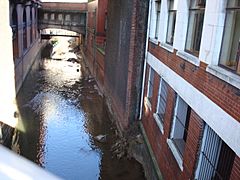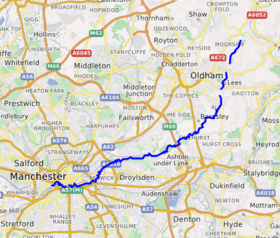River Medlock facts for kids
Quick facts for kids River Medlock |
|
|---|---|

River Medlock running under Oxford Street/Oxford Road, Manchester
|
|
 |
|
| Country | England |
| Physical characteristics | |
| Main source | between Oldham and Saddleworth, Pennines |
| River mouth | River Irwell 53°28′26.67″N 2°15′12.31″W / 53.4740750°N 2.2534194°W |
The River Medlock is a river in Greater Manchester, England. It starts in the Pennines mountains, between Oldham and Saddleworth. The river then flows south and west for about ten miles (16 kilometers). It finally joins the River Irwell in the center of Manchester.
Contents
The River's Journey Through Manchester
The last few miles of the River Medlock, as it flows towards the River Irwell, have changed a lot over time. Much of the river in this area flows underground in tunnels called culverts.
Underground Sections
The river goes under the car park of the City of Manchester Stadium. It then appears briefly under a bridge on Baring Street, near Piccadilly station. After that, it goes underground again. It flows beneath the former University of Manchester Institute of Science & Technology campus. The river then appears again at Gloucester Street. It flows under the old gasworks at Gaythorn before showing up at City Road East.
Meeting the Bridgewater Canal
Where Deansgate and Chester Road meet, the river comes face-to-face with the Bridgewater Canal. There is a special gate, called a sluice gate, at this spot. This gate used to let water from the Medlock flow into the canal. However, the Medlock's water became too polluted to be used for the canal.
Normally, the river flows several feet below the canal. The Medlock goes through a tunnel under the Castlefield canal basin. It then reappears at Potato Wharf. Here, extra water from the canal drains into the river through a circular weir. When the river has a lot of water, like after heavy rain, the tunnel cannot hold it all. In these cases, river water flows into the canal basin. It then exits through the weir and special gates. A short distance further, the Medlock joins the Irwell. This happens near the bottom gate of the old Hulme Locks.
River Medlock's Past Use
In the late 1700s, people could use boats on parts of the River Medlock. It was possible to travel between the Bridgewater Canal at Deansgate and India House on Whitworth Street.
Coal Transport Tunnel
Near India House, there was an entrance to a tunnel. This tunnel was used to carry coal by boat to a wharf at Store Street, close to Piccadilly station. You can still see the mouth of this old tunnel today. However, the river became too full of mud and dirt, making it hard for boats to pass. Also, the Rochdale Canal was built, which made the tunnel less useful. Because of these reasons, the tunnel was no longer needed.
Interesting Places Along the Medlock
The River Medlock flows past several important historical spots in Manchester.
Little Ireland
Just south of Oxford Road railway station, there was an area called Little Ireland. This area was bordered by the railway line and a bend in the river. A famous writer named Friedrich Engels described it as a very difficult place to live. A red plaque on the wall of 8 Great Marlborough Street remembers this area. It is located between New Wakefield Street and Hulme Street.
Friedrich Engels Statue
About half a kilometer west of the plaque, you can find a Statue of Friedrich Engels at Tony Wilson Place. This statue was moved from Ukraine after the Soviet Union broke apart. The now-underground River Medlock flows beneath this area, between Anne Horniman Street and City Road East.
Tributaries of the Medlock
A tributary is a smaller stream or river that flows into a larger one. The River Medlock has several tributaries:
- River Tib
- Shooter's Brook
- Newton Brook
- Lord's Brook
- Lumb Brook
- Taunton Brook
- Holden Brook
- Little Bankfield Brook
- Rabbit Brook
- Rowton Brook
- Thornley Brook
- Ashes Brook
- Wood Brook
- Sheep Washes Brook
- Roebuck Low Brook
Images for kids
See also
 In Spanish: Río Medlock para niños
In Spanish: Río Medlock para niños


